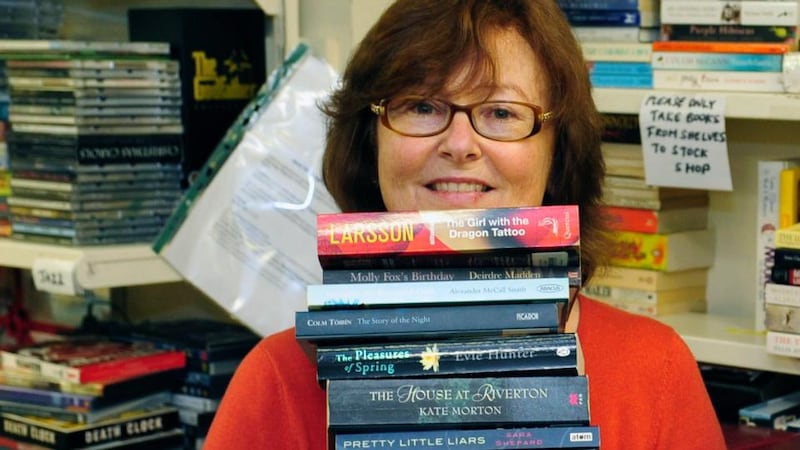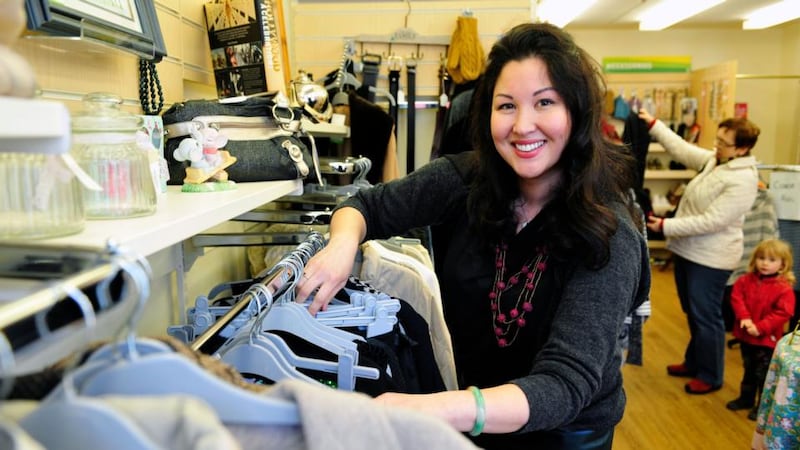I'm rummaging through my first bag of the morning when I pick out a bra so big you could use it as a parachute. I put this somewhat unconventional donation to one side and start looking more carefully through the bag, which has just been left into the Oxfam shop in Rathfarnham, where I'm volunteering.
I wish now I had accepted the offer of latex gloves from one of my co-workers. But the bag contains no further undergarments. There's a copy of the RTÉ Guide, a toilet-roll holder, a plastic cup and a Christmas decoration.
Luckily, the rest of the day’s donations amount to quite the treasure trove. There’s a vintage kerosene heater from a glass house and an ancient can for spraying pesticides on plants. And books. Mountains and mountains of books.


This is just one link in the Oxfam chain. It has 28 shops in the Republic and 22 in the North. While clothes and accessories, books and music are the big sellers, the network also sells furniture, computers and even reconditioned iPads. There’ s an Oxfam Books in Belfast, Cork and Dublin, and Oxfam Home in Belfast and Dublin.
And then there are Oxfam Bridal on South Great George’s Street in Dublin and Main Street in Bangor, Co Down. This is where big savings can be made. The minimum price for a wedding dress is just €50 and the maximum €500.
At an Oxfam bridal fair in the George’s Street shop on March 21st and 22nd, 90 per cent of the dresses will be brand new, donated by bridal boutiques.
This year Oxfam is selling a Vera Wang wedding dress, which was donated from the UK. And the price is €1,000; that's "€2,000 less than one would otherwise spend on it". The donor specifically wanted the dress to go to the Irish shops, and is keen to know who buys it.
The high-end stuff
Back in Rathfarnham, shop manager Sylvia Mo is telling me what I need to do and some of what I need to know.
“Women over 30 are our biggest customers and tend to be looking for the high-end stuff,” she says. “We try to give the shop a boutique feel because there’s still a stigma attached to charity shops. We saw a lot of new customers with the recession, but I also know a lot of wealthy women who come in. They are just looking for something different .”
She sees me eyeing the men’s clothes. “We get a lot of lovely men’s stuff, but don’t get so many men in. It can be hard to get them to come in. It’s a pity.”
She tells me suits with labels such as Armani and Hugo Boss can sometimes be found here. Not today, however.
There’s a Reiss top selling for €12, a DKNY dress for €25 and lots of Monsoon dresses with prices as low as €5. There are M&S clothes and other name brands selling for prices that are hard to believe.
“One of the downsides is that we don’t really have much choice when it comes to colours or sizes,” says Mo, who has been manager here for seven years. “We might get people saying they like a certain top but would prefer it in blue. That’s not the way it works, though.”
Whatever way it works from shop to shop, the global picture is more important.
The shops "are a vital source of income for our work around the world," says Oxfam Ireland spokeswoman Alice Dawson. "The money raised is used in three ways: emergency responses such as the current crisis in South Sudan, long-term development projects that lift people out of poverty, and campaigning that gives a voice to the vulnerable."
The shops have an average net profit of 22 per cent, much higher than the high street average of 5 per cent.
According to Mo, the amount and quality of donations “did dwindle with the start of the recession”. But things might be picking up again.
"Recently we got an 18-carat gold necklace that would normally sell for around €1,400. We might put it up for auction on Twitter or Facebook to see what we can get; it might fetch €600."
Hard sells
Not everything in the shop is so lovely. It’s hard to imagine that the collection of porcelain dogs will ever find a new home, or that anyone will ever have the urge to buy a mismatched collection of crockery.
That's what I think, but I am wrong, says Sarah Williams. "I am collecting old tea sets and plates and glasswear for my vintage-style wedding," she tells me. "I want everything to be mismatched and, rather than hiring it, I have been trawling charity shops for months. My wedding is in the summer and I must have 15 sets by now. I need about 100 cups and saucers, so I have a lot done but more to do."
Jackie Carroll comes through the doors. She has a rummage through the racks but finds nothing to her taste. She will return, however: she is a big fan of the charity-shop experience.
“I get a real buzz from coming in. I get a lot of vintage bags.” How many bags can one person need? “One I bought for €50 I sold online for €300.” Right.
The staff are clued-in, so the chances of a real bargain selling for a song are slim. They have an auctioneer on Francis Street in Dublin who offers his services free when it comes to genuine antiques, and they know enough about collectable books to recognise first print runs of first editions, or how to spot a valuable doll.
"Someone dropped a copy of Mein Kampf into the George's Street store," says Mo. "They'd normally sell for well over €1,000. I think someone from The Irish Times ended up buying it."
I look to see if she’s winding me up. She doesn’t seem to be. It wasn’t me, that’s all I know.
Two days a week, Aidan McNamara (32) looks after the toys, CDs and DVDs. He is a Special Olympian, having competed as a golfer, and is assiduous at making sure everything is up to scratch before he tags it and puts it out for sale.
I mention that I've been on the hunt for a Sopranos box set. Quick as a flash Aidan finds exactly what I've been looking for, and for €5 it's mine. I put it in my pile alongside a twin-statue set of Don Quixote and Sancho Panza, the Reiss top and a dress from Monsoon (neither of which is for me), a leather belt and a game of Snap in Irish (again, not for me).
All told, I spend €60 and walk away with a bag of stuff that would easily have cost me more than €300 had I sourced it new.
With numbers like that, it’s hard to argue with the wisdom of taking a second look. And the profits made by the store go towards improving the lives of impoverished people? That’s hard to top.








